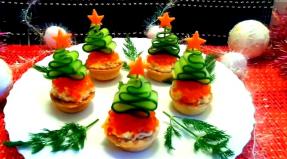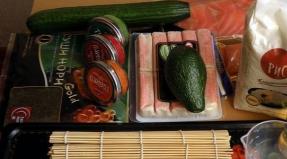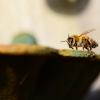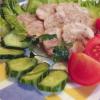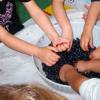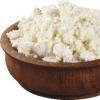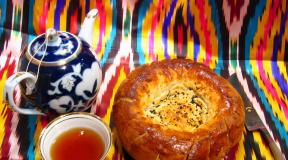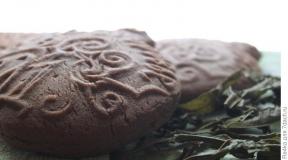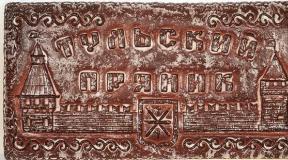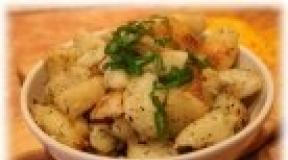Interesting on the net! Overseas exotic: New Year's dishes from different countries.
Decorate the New Year 2012 menu with dishes from France, Poland, England, Germany and the Czech Republic.
© ShutterstockPrepare a colorful meat, fish dish or dessert from the New Year's menu from different countries of the world for the New Year's table. Choose a New Year's recipe
New Year's recipes from around the world
1.France
Turkey is the main dish of the New Year's table in France. The French joke: "If there is no turkey, then the New Year may not come."

New Year's Eve Recipes 2017 with photo © Shutterstock
French turkey
Ingredients
0.5 kg turkey fillet, 5 small onions, 2 tomatoes, 300 g cheese, mayonnaise, spices, salt to taste.
Preparation
Cut the turkey fillet into thin layers and place in a bowl, sprinkle with spices and salt. Cover with a lid, put the load on top and leave for 20-30 minutes to marinate in your own juice.
Wash the tomatoes and cut into slices, cut the onion into rings. Sodium cheese on a coarse grater. Put a sheet of foil on a baking sheet, tuck the edges. Spread the layers of turkey evenly in one layer, lightly smear with mayonnaise on top. Then add a layer of onions and a layer of tomatoes. Cover everything with cheese on top.
Bake in the oven for about an hour. First over high heat, then over low heat. Serve the dish hot, garnish with herbs.

2.Poland
On the New Year's table in Poland, there is always fish, which is considered a symbol of prosperity and family happiness.
Fish in Polish
Ingredients
300 g pike perch fillet with skin, 1 carrot, 4 g parsley root, 2-3 boiled eggs, 20 g butter, 1 tbsp. l. lemon juice, parsley, salt - to taste.
Preparation
Cut the fish fillet into portions, boil in salted water with the addition of carrots and parsley root.
For the sauce, combine the melted butter with chopped eggs, lemon juice, chopped herbs and 2 tbsp. l. fish broth.
When serving, put the fish on a dish, pour in the prepared sauce. Alternatively, garnish with mashed potatoes and carrots.

3.Czech Republic and Slovakia
In these countries, the New Year's table is not complete without a fragrant national dessert - apple strudel.
Apple strudel
Ingredients
250 g flour, 1 egg, 150 g butter, 1 tsp. vinegar, 1 kg of apples, 80 g of sugar, 30 g of raisins, 100 g of bread crumbs, ground cinnamon, lemon zest - to taste.
Preparation
Sift the flour, then pour in the whipped with 6 tbsp. l. warm water egg, 1 tbsp. l. melted butter, vinegar, add salt and knead to a soft shiny dough. Roll into a ball and leave for 30 minutes, covered with a damp cloth.
Cut the dough in half, roll each half on a flaxseed towel dusted with flour. Stretch the dough from the center in all directions, trying not to tear, sprinkle with melted butter, put a layer of peeled and chopped apples on it, sprinkle with sugar, cinnamon, washed raisins, chopped zest and bread crumbs fried in 30 g of butter.
Raising the edge of the towel, roll the dough into a roll. Transfer to a baking sheet and bake in a moderately heated oven for 30 minutes, brushing occasionally with oil. Cool the finished strudel and cut into slices. Serve and decorate to taste. For example, nuts, mint sprigs, cinnamon or powdered sugar.

4.Germany
In this country, pies and other dishes with raisins, apples and nuts are always served on the New Year's table. Moreover, each ingredient has its own meaning. For example, nuts are the ability to learn secrets and overcome the difficulties of life, and raisins are a symbol of abundance.
Cakes with nuts - a recipe from Germany
Ingredients
2 eggs, 2 egg yolks, 200 g sugar, 6 tbsp. l. crackers, a pinch of salt, 2 tsp. dry yeast, 1 tbsp. l. flour, 0.5 tbsp. chopped raisins, 1 tbsp. nuts, 200 g butter, 0.5 tbsp. milk.
Preparation
Beat eggs and sugar, add salt, crackers, yeast mixed with flour, raisins and 0.5 tbsp. nuts. Knead the dough, roll it into a layer 0.7 cm thick, place on a baking sheet covered with oiled paper and bake in the oven for 15 minutes on medium heat.
For the cream, beat the yolks with sugar, pour in hot milk, stirring occasionally. Warm up, whisking continuously, in a water bath until thickened. Cool the resulting mass, combine with whipped butter and beat everything together until fluffy. Add 0.5 tbsp. chopped nuts and mix.
Immediately cut the baked crust into rectangular cakes, let them cool, then cover with cream and garnish to taste.

5.England
The traditional dessert on the New Year's table in this country is pudding. Before serving, the festive pudding is sprinkled with rum and set on fire. A very effective decoration for the New Year's table, especially in the Year of the Dragon 2012!
The British put Christmas plumpudding on the table. It is prepared from lard, bread crumbs, flour, raisins, eggs and various spices. Before serving, the pudding is poured over with rum, set on fire and flaming is placed on the table.
In addition to pudding, turkey is served with gooseberry sauce. In general, for any holiday in England, a stuffed turkey with a vegetable side dish is served.
America
But on holiday tables Austria, Hungary, Yugoslavia there is never a Christmas goose, duck, chicken, turkey - they think that it is forbidden to eat a bird that evening - happiness will fly away.Cheese pies. Often a coin is put in a cake or pies, it is believed that wealth (or a broken tooth) awaits the finder.
Vietnam
 |
Germany
In Germany, on New Year's Eve, there must be herring on the table, it brings happiness in the coming year. They also prepare New Year's cake, pork with stewed cabbage.
Also at Christmas, brightly colored dishes with apples, nuts, raisins and all the pies that were baked this week are definitely served. The symbolism here is special: the apple remained from the apple tree of the knowledge of good and evil in paradise, nuts with a hard shell and tasty cores mean the secrets and difficulties of life, as the embodiment of the proverb: "God gave a nut, but man must crack it." Even in Denmark, they eat duck or goose stuffed with fruits (usually apples), rice pudding sprinkled with cinnamon, sweet rice porridge with cinnamon and raisins (according to custom, the porridge pot is left open all Christmas night so that the gnomes can enjoy Christmas food and did not harm the owners of the house throughout the next year).In contrast to Protestant Lutheran Denmark, where fasting is not observed, Catholics Lithuania on the eve of Christmas, only lean food is eaten. Their Christmas table consists of a slice (kutya), salads, fish dishes and other lean meals that do not contain meat. Only the next day, on Christmas itself, after a family visit to the church, is it allowed to taste a roast goose.
Christmas is celebrated on a grand scale. As many different dishes as possible are prepared. Popular sweets are wine dough pies, almond cakes, and caraway cookies. Even in Spain, they eat fried lamb, shellfish, turkey, suckling pig.Israel
IN Portugal- dried salted cod, very sweet port. Prepare 2-meter colored columns of rice, after symbolic rituals of sacrifice to the gods, are taken away to their homes.Italy
Consumes blood sausage, apples, local sparkling wine.Netherlands
The Dutch present at the New Year's table such a delicacy as deep-fried donuts. Fried chestnuts, pies. They also eat oysters, foie gras, champagne and cheeses.Poland
Be sure to fish - it, especially carp, in many countries is considered a symbol of family happiness and well-being; mushroom soup or borscht; barley porridge with prunes; dumplings with butter; for sweet chocolate cake. IN Romania, Australia, Bulgaria they bake New Year's pies, and not simple ones, but with surprises: whoever gets a coin baked in the filling, a nut, a pepper pod will get a family next year, he will be lucky.Scotland
 |
Today in Scotland, a large round shortbread cake is baked for the New Year's table, topped with sugar-boiled almonds, nuts, sweets, sugar and marzipan figurines. They are usually decorated with national emblems: heather, Scottish cross, arms crossed over the sea, mountains and others.
Sweden
"Lutefix" - a fish dish made from dried cod, pork.
China
Even on New Year's Eve, most Chinese people eat fondue. A pot with meat broth is placed in the middle of the table, and a fire is made under the pot. Meat (beef, lamb), fish, squid, shrimp, and other seafood are cut into slices as thin as paper, laid out on plates and placed around the pot. The guests sit around the table and prepare their own food. When the water boils, each person takes a slice of meat, fish, or other favorite food and immerses it in the boiling broth. When the slice is cooked, it is dipped in soy sauce and consumed with pleasure.Finland
In the Philippine Islands, people prepare a wide variety of food on New Year's Eve, the more food the better, since a rich New Year's table is considered the foundation of an equally rich edible coming year. IN Tibet housewives bake mountains of pies with a wide variety of fillings to present to all acquaintances and strangers: the more you distribute, the richer you will be.Japan
In the temples of Japan on New Year's Eve, at exactly 00:00, the most ordinary noodles are put on the table. The noodles must necessarily be not chopped, since the longer the noodles, the longer our life.In general, housewives in Japan prepare food for the New Year from products that, as they believe, bring happiness: seaweed gives joy, fried chestnuts - success in business, peas and beans - health, boiled fish - calmness, good spirits, herring caviar - happy family, many children. Japanese families are enjoying themselves, sitting on their knees around a low table, decorously without noisy conversations and drinking songs - nothing should distract from thoughts about the future, about what awaits in the coming year.
Well Russia · Ukraine · Belarus…
Almost until the middle of the 19th century, the Russian New Year's menu did not exist, and what is now considered an invariable part of the New Year's table - all these suckling pigs with buckwheat porridge and geese with sauerkraut or apples - actually came from the Christmas table. At the beginning of the 19th century, the cuisine was not complicated. Even in the homes of the nobility, pickles and mushrooms, radish salad could well be on the New Year's table. And they also served a piglet, veal fricassee, fried bullets, boiled trout in wine, ruff body. And, by the way, apricots, oranges, grapes and pears - greenhouses were in vogue, fruits were grown in the middle of winter in St. Petersburg and in Moscow. |
The second coming of the Olivier salad has come - with doctor's sausage instead of hazel grouses. It was cooked in a large basin and generously seasoned with mayonnaise. A pig, goose, or duck were welcome but not required. It was imperative to open a bottle of "Soviet Champagne" to the chimes.
And for the older generation, with the advent of televisions, the table finally won out.In the New Year, they always try, there is something that the animal in whose honor the year is named likes. Once upon a time, "Goose in apples" was considered a traditional dish on the table. Today, this half-forgotten tradition is, unfortunately, a rarity, but "Olivier" and "Fur coat" have become familiar and, indeed, folk!
We wish you abundant New Year's table!
Sources: newyear.redday.ru, kulinarochki.ru
Photos are from the Internet.
If you are planning to celebrate the New Year in home comfort, gathering guests at a large festive table, then this article will help you in preparing for the celebration and preparing treats that will not leave guests indifferent. Considering the fact that the coming year is the year of the horse according to the eastern calendar, let us recall the magnificent tradition of preparing dishes that this symbol likes. The horse is not a picky animal, it is herbivorous, but treating guests with light salads and vegetables with fruits is not enough. Let's keep in mind that the presence of such treats must be present on the table in order for the year to pass successfully. Let's see what is traditionally served on the New Year's table in different countries of the world. There is definitely something to your liking in the variety of traditional dishes.
England
Not a single traditional New Year's Eve in England is complete without plumpudding, which consists of lard, bread crumbs, flour, raisins, eggs and spices. Before serving, the pudding is sprinkled with rum and set on fire, which makes the holiday even brighter. Stuffed turkey with vegetables and gooseberry sauce is also traditionally served on the table. Turkey with vegetables is considered a traditional dish and pleases guests at any holiday.
America
Ideyka is also considered a traditional American dish, however, unlike the English one, the American turkey is prepared differently. In very simple terms, the turkey is stuffed with all the products that are "lying around" in the refrigerator. Usually it is cheese, garlic, prunes, apples, cabbage, beans, mushrooms, spices.
Austria, Hungary
In these countries, serving a bird to the festive table is a bad sign. Superstitious residents of these countries believe that if you serve a bird to the festive table, then happiness can fly away. Traditional Austrian cuisine is rich in its own delicacies. So, for the festive table you can serve schnitzel, strudel, you can also prepare a traditional Austrian fish salad. In Hungary, it is customary to serve traditional bagels for the festive table - poppy and nut rolls, which migrated from Jewish cuisine.
Denmark, Sweden
The main New Year's festive dish of the Danes is cod. This dish symbolizes happiness and wealth. Lutefix, a fish dish made from dried cod, is always served on the Swedish festive table.
Germany
Herring is considered an integral and symbolic dish on the festive table in Germany. It is believed that herring will definitely bring happiness in the coming year. Traditional and equally important dishes on the festive table are Sauerkraut - stewed sauerkraut with sausages, Eisbein - boiled pork knuckle and, of course, many types of German sausages. (each region has its own varieties).
Israel
It is important to note that Israel celebrates the New Year in September. The New Year's festive table for the people of Israel has a number of its own rules. The main rule is that bitter, sour and salty foods are removed away. The table is covered with sweet dishes. Also, honey, dates, pomegranates and apples are usually present on the table. Challah - a festive pastry - is dipped in honey. This tradition is followed by many people. Thus, the Israelites "sweeten" the coming year. Boiled fish, baked apples, cabbage, beets are also served on the festive table.
Holland, France
On the Dutch festive table, you will surely find deep-fried donuts and salted beans - one of the main national dishes - just for the New Year. In France, the traditional New Year's table is not complete without fried chestnuts, oysters, beautifully decorated sandwiches with goose pate, cheeses and, of course, French wine.
Poland
The traditional Polish New Year's table has 12 dishes. An old Polish tradition is to eat a piece of herring while the clock chimes. It is believed that the sharper the herring. The more successful the year will be. Fish is considered an obligatory dish, especially carp - a symbol of family happiness.
Romania, Australia, Bulgaria
Among the many traditional dishes presented at the festive New Year's tables, you are sure to try a special cake. Its peculiarity is that one of the guests in a piece of cake will surely come across a coin, or a nut, or a peppercorn. The happy owner of the find will start a family next year.
Japan
On December 30, mochi is always present on the pre-holiday table - small cakes made from boiled rice, which are made with fruits and sprinkled with sesame seeds. Long noodles must be present on the New Year's festive table. The longer it is, the longer the life of the participants in the feast will be. On the tables there is often seaweed, fried chestnuts, peas, beans, boiled fish, these components are a guarantee of happiness, success in business, health, peace of mind.
New Year is a special holiday shrouded in miracles, magic and symbols. One of these symbols is the New Year's table. In different countries of the world, people believe that special holiday food can bring happiness in the new year and traditionally prepare these dishes. Let's see what kind of food will be on the New Year's table in different countries.
England
Not a single traditional New Year's Eve in England is complete without plumpudding, which consists of lard, bread crumbs, flour, raisins, eggs and spices. Before serving, the pudding is sprinkled with rum and set on fire, which makes the holiday even brighter. Stuffed turkey with vegetables and gooseberry sauce is also traditionally served on the table. Turkey with vegetables is considered a traditional dish and pleases guests at any holiday.
America

Ideyka is also considered a traditional American dish, however, unlike the English one, the American turkey is prepared differently. In very simple terms, the turkey is stuffed with all the products that are "lying around" in the refrigerator. Usually it is cheese, garlic, prunes, apples, cabbage, beans, mushrooms, spices.
Austria, Hungary

In these countries, serving a bird to the festive table is a bad sign. Superstitious residents of these countries believe that if you serve a bird to the festive table, then happiness can fly away. Traditional Austrian cuisine is rich in its own delicacies. So, for the festive table you can serve schnitzel, strudel, you can also prepare a traditional Austrian fish salad. In Hungary, it is customary to serve traditional bagels for the festive table - poppy and nut rolls, which migrated from Jewish cuisine.
Denmark, Sweden

The main New Year's festive dish of the Danes is cod. This dish symbolizes happiness and wealth. Lutefix, a fish dish made from dried cod, is always served on the Swedish festive table.
Germany

Herring is considered an integral and symbolic dish on the festive table in Germany. It is believed that herring will definitely bring happiness in the coming year. Traditional and equally important dishes on the festive table are Sauerkraut - stewed sauerkraut with sausages, Eisbein - boiled pork knuckle and, of course, many types of German sausages. (each region has its own varieties).
Israel

It is important to note that Israel celebrates the New Year in September. The New Year's festive table for the people of Israel has a number of its own rules. The main rule is that bitter, sour and salty foods are removed away. The table is covered with sweet dishes. Also, honey, dates, pomegranates and apples are usually present on the table. Challah - a festive pastry - is dipped in honey. This tradition is followed by many people. Thus, the Israelites "sweeten" the coming year. Boiled fish, baked apples, cabbage, beets are also served on the festive table.
Holland, France

On the Dutch festive table, you will surely find deep-fried donuts and salted beans - one of the main national dishes - just for the New Year. In France, the traditional New Year's table is not complete without fried chestnuts, oysters, beautifully decorated sandwiches with goose pate, cheeses and, of course, French wine.
Poland

In Poland, there are exactly twelve dishes on the New Year's table. And not just one meat! Mushroom soup or borscht, barley porridge with prunes, dumplings with butter, chocolate cake for sweet. An obligatory dish is fish. In many countries, she is considered a symbol of family happiness and well-being.
Czech Republic and Slovakia

A similar set of dishes is present on the New Year's tables of housewives in the Czech Republic and Slovakia. True, they prefer pearl barley porridge, and strudel is required - a puff roll with apples, the pride of every good housewife.
Romania, Australia, Bulgaria

Among the many traditional dishes presented at the festive New Year's tables, you are sure to try a special cake. Its peculiarity is that one of the guests in a piece of cake will surely come across a coin, or a nut, or a peppercorn. The happy owner of the find will start a family next year.
Japan

On December 30, mochi is always present on the pre-holiday table - small cakes made from boiled rice, which are made with fruits and sprinkled with sesame seeds. Long noodles must be present on the New Year's festive table. The longer it is, the longer the life of the participants in the feast will be. On the tables there is often seaweed, fried chestnuts, peas, beans, boiled fish, these components are a guarantee of happiness, success in business, health, peace of mind.
Spain, Portugal, Cuba

In many countries - Spain, Portugal, Cuba, the vine is considered a symbol of abundance and a happy family hearth since ancient times. Therefore, the inhabitants of these countries with the striking of the clock at midnight eat twelve grapes - according to the number of strikes of the clock. A wish is made with each grape - twelve cherished wishes for every month of the year.
Italy

In Italy, it is also customary to serve grapes, nuts, lentils to the New Year's table, as a symbol and guarantee of longevity, health and well-being.
Tibet

The people of Tibet have a nice New Year's custom. The hostesses bake mountains of pies with a wide variety of fillings and present them to all acquaintances and strangers. The more you distribute, the richer you will be!
Belgium

In Belgium, they eat veal sausage with truffles, boar meat, traditional cake, wine.
Any country can boast of its own peculiarities of festive national cuisine. And yet there is one general trend: on New Year's Eve or at Christmas, symbolic dishes should appear on the table in a strict order.
Now let's get acquainted with what delicacies adorn holiday tables in various countries of the world.
Italy
Italy, like most European countries, celebrates Catholic Christmas. It is customary to celebrate New Year and Christmas here with approximately the same menu. The only difference is that the Christmas menu does not contain meat products; Italians cook fish for hot meals.
Well, after Christmas, Italian housewives personally make kotekino pork sausage, serving it to the table with lentils. The latter has long symbolized many years, health and all the benefits in the family.
England

The British traditionally prepare stuffed turkey for the Christmas holidays, serving it along with a vegetable side dish. For dessert one hundred percent - pudding. The preparation of this sweet is special, since bread crumbs, flour, bacon with raisins, eggs and various spices are involved. Before serving, the dessert is sprinkled with rum and set on fire. Such a burning pudding symbolizes an active life position.
France

The Christmas menu in France is very different depending on the region. For example, in the northeast of the country they prefer to cook a goose, in Burgundy they like turkey, in Provence, a must-eat treat is bûche de Noël - a traditional dessert that people have come to love outside of France.

Parisians celebrate the main holidays of the year with oysters. This is a must-have attribute of the Christmas table. The hostesses also make sandwiches with foie gras and cheese. All this exotic is washed down with French wine.
Smoked ham, salads, sausage are considered typical for all French dishes.
Germany

Fondue and raclette are considered traditional Christmas treats among the Germans. The tradition of serving carp to the New Year's table is gradually becoming a thing of the past.
For drinks, the Germans prefer champagne, punch or traditional punch.
Czech Republic

Czech apple strudel is an indispensable New Year's meal. This very tender roll with apples on puff pastry will not leave indifferent any of the relatives and guests. Strudel is eaten with ice cream, cream or jam. Czechs usually prepare a simple festive table for the New Year with quite hearty dishes. Carp must be fried and eaten with potato salad. Dessert dishes are gingerbread and cookies.
Portugal

The Portuguese love to eat grapes on New Year's Eve. They believe that wine berries are a symbol of wealth and happiness in the family. As soon as the clock starts beating 12 times, the Portuguese try to contrive to eat 12 grapes. How many grapes, so many desires. The same custom exists in Italy.
Among the traditional Portuguese dishes on the Christmas table, you can often find octopuses in rice, roast lamb or goat meat. The Portuguese pay special attention to baking. Bolorey Christmas Cupcake - this dessert should be tasted by every guest of this beautiful country who happens to be here during the Christmas holidays.
Denmark

A classic Danish dish is fried goose stuffed with dried fruits. This dish is placed on the table with a golden brown crust. Alternatively, baked pork can be used. It is served with potatoes and red cabbage salad.
The traditional Danish dessert, grütze, is a porridge made of rice, seasoned with toasted almonds and very thick berry jelly. Danes usually drink mulled wine or beer.
Iceland

Traditionally, Icelanders roast venison and ferment herring. The latter is mainly consumed in a restaurant or ordered at home already cooked, since the room may smell bad when cooking.
Also, baked turkey, leg of lamb or pork can often be found on the Icelanders' Christmas table.
Poland

Polish housewives prepare exactly 12 different treats for the New Year's table. The main condition for dishes is the absence of meat. The queen of the table is fish cooked in different ways: baked, aspic, fried. For Poles, fish symbolizes family well-being. And also the fish is one of the symbols of the Christian faith. Fish are served with soups, cereals, potatoes, kutya, dumplings, apples, nuts and various pastries.
Netherlands

The Dutch consider donuts to be the main New Year's dish, which are deep-fried and sprinkled with powdered sugar. In addition, all the main main courses contain salty beans, which are considered to be the traditional Dutch food.
But traditional European cuisine is also a must on the Dutch festive table. This is fried beef, pheasant, glazed hams. American culture has also made adjustments to the Christmas menu with roast turkey.
An interesting New Year's custom came to the country from the former Dutch colony - Indonesia. Each guest, coming to the house for the holidays, brings with him a small frying pan with some festive dish, which is laid out on the common table.

Nepalese New Year takes place in April. This holiday has a unique name - Bisket Jatra. Nepalese do not so much pay attention to the rich table as to the spectacles. Noisy musical theatrical shows are popular. When the Nepalese get to the table, there are usually dishes from the cuisines of India and Tibet. The most common lentil dish is dal baht.
Mexico

Mexicans prefer spicy food. That is why romeritos appears as an obligatory attribute on the festive table of Mexicans. This exotic is prepared from dried shrimp, potatoes and a plant similar to rosemary. In addition, by tradition, stuffed turkey is eaten, a lot of corn with beans and sweet bunuelos pancakes. Mexicans love to drink tequila, punch, or light wine.
Vietnam

The Vietnamese call the New Year Tet and they celebrate this holiday according to the lunar calendar. Each year, different dates fall for the new year, ranging from January 20 to February 20. Rice and meat are the ingredients of the festive dishes. Vietnamese delicacies include pork in coconut milk and banh chung pie. The technology of cooking chung baths is as follows: mixed rice with pork is wrapped in bamboo leaves, after which it is fried.
Japan

Unlike European countries and America, where Christmas is considered the main winter holiday, New Year is such here.
The Japanese New Year's table here is markedly different from the rest of the world. The Japanese call their New Year's dishes in one word - osechi-ryori. These are, as a rule, boiled seaweed, fish pie, sweet potato puree with chestnuts, and sweet soy.

It's hard to imagine New Years festivities without the traditional Japanese mochi cakes made from glutinous rice. There are a lot of varieties of mochi, the Japanese love to give them as gifts to relatives and friends.
The symbolic food of the Japanese is chestnuts. In Japan, they believe that having eaten chestnuts, a person will be successful in all his affairs. For this reason, chestnuts are added to many New Year's dishes: side dishes and desserts. Chestnuts are also found in mochi cakes made from boiled rice. A Japanese New Year's table will be incomplete if there is no seaweed, beans and herring caviar on it.
America

In the USA, as in many other countries, they prefer to cook turkey stuffed with vegetables or apples for Christmas. The cooking method is special. The festive bird is stuffed with everything in the refrigerator.
Some Americans prepare a drink for the holiday called eggnog, which consists of eggs, powdered sugar, brandy and milk.
Canada

Canadians celebrate New Years just like the British or Americans: with stuffed turkey, mashed potatoes, cranberry sauce, vegetables, and raisin pudding for dessert. Butter cakes and shortbread cookies are among the sweet dishes on Canadian holiday tables.
Australia

Here Christmas is celebrated in the middle of summer (December and January are summer months in the southern hemisphere of the planet), so traditionally the family goes out into the countryside and has a barbecue. Favorite dessert is strawberry meringue or ice cream.
And about the most you can find out in one of the articles on our site site.
Argentina

Argentines also celebrate the New Year with Christmas in the summer. The main course is veal and tuna, seasoned with sauce or mayonnaise. It is impossible without capers. Europeans cannot understand such an explosive combination, but Argentines claim that it is very tasty.
